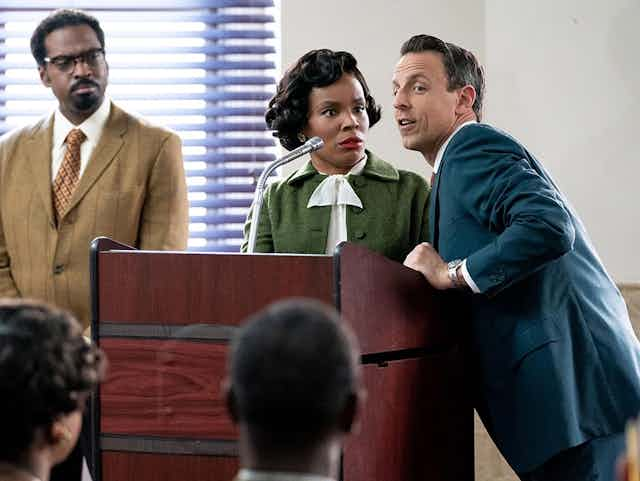A little while ago, two comedians on a late-night show poked fun of the “white saviour complex.” It’s the idea that people of colour, whether in the Global South or in the West, need “saving” from a white western person or aid worker.
The comedians, Seth Meyers and Amber Ruffin, were talking about representation in movies, but the issue of white saviourism and colonial attitudes, especially in international development, is very real.
Accusations of white saviourism often include a story about white international volunteers taking selfies with Black children. However, such voyeuristic tourism is just the tip of the iceberg.
White saviourism – in theory and practice
These conversations are not new. More than a decade ago, writer Teju Cole defined the white saviour mentality as “an emotional experience that validates privilege.” Cole described white saviourism as an intricate web of North/South power relations that involve for example American-backed coups and western interests in Africa.

Cole discusses a now infamous social media campaign and documentary, #Kony2012 led by the American organization Invisible Children and its founder Jason Russell. #Kony2012 focused on the importance of arresting the Ugandan militant Joseph Kony, then the No. 1 war criminal for the International Criminal Court.
The impulse behind Russell’s short documentary was that western populations did not know about Kony and that the conflict would resolve itself if they knew. It was based on Russell’s quest to help Ugandans. “Everything in my heart told me to do something,” Russell said in the movie. But Russell never went into depth with expert sources and he did not offer real potential solutions to the conflict.
Ugandan writer Rosebell Kagumire says white saviour narratives often lessen the complexity of African socio-political situations. In so doing, they also ignore the role of western countries in encouraging inequalities and wars in the Global South.
Read more: The other WE Charity scandal: White saviourism
Aid workers in unequal power structures
Scholars have described aid workers as “missionaries of development” who represent a system supported by individuals with good intentions who avoid criticizing capitalist mechanisms of exploitation.
This paradox means that our economic system continues to exploit Global South populations for private gains, while international organizations try to help with localized development interventions. All this is undergirded by the western self-perception that westerners are more capable, intelligent and thus more “developed.”
White saviuorism is thus both a state of mind and a concrete unequal power structure between the Global North and the Global South based on white supremacy and exploitation.
As Frantz Fanon said in the Wretched of the Earth, white people’s subjectivity is always confirmed, whereas non-whites are victimized. Indeed, most initiatives by European and western donors to address inequality in the non-western world thrive on the assumption that the latter cannot manage themselves and that only external “white saviours” can put things in order.
Common threads
As development practitioners and scholars from three countries (Uganda, Pakistan, and Canada) who have witnessed these issues within our fields, we decided to invite those impacted by white saviourism to voice their understandings of it.
We discussed the issue with 15 people from the Global South with diverse professional backgrounds. They talked about their scholarship and lived experience of white saviourism in international development.
In our conversations and then in our edited volume, White Saviorism in International Development: Theories, Practices and Lived Experiences, we found several common threads of white saviourism.
The contributors described the many woes of the international development industry: its racist tendencies, colonial attitudes, lack of accountability, lack of respect for its subjects and the lack of inclusion of those it works with and its attitude of superiority over others.
These include the continued dispossession of Indigenous people from their lands; the role that white women play in white saviourism; the perpetuation of the saviour complex by “Brown” saviours who take on the mantle in their own countries; how organizations of the Global North steal space from those in the Global South — a space that is not their own.
Today’s buzz-worthy phrase: ‘Decolonizing aid’
The goal, “decolonizing aid,” has become buzz-worthy in recent years and organizations, activists and civil society organizations have set up task forces, and indexes, published reports here and there about this issue. They have recorded podcasts, listed tons of resources, organized conferences and written books and articles.
Read more: Why it's time to end child sponsorship
But as international development practitioner and researcher Themrise Khan points out, racism does not only exist within aid: it’s the structure the sector is built on.
To tackle that racism and “decolonize aid,” international development practitioners and scholars first need to understand the structure of white supremacy it is based on. This does not mean North/South solidarity should not exist, but that we need to reinvent its foundations.
Global South observers have voiced this same criticism for decades now, but western organizations and individuals have been slow to hear them.
International involvement in Haiti is a seminal example of this contradiction, as Rose Esther Sincimat Fleurant indicates in her chapter in our book.
On the one hand, the country was founded on the freedom of previously enslaved peoples, who were then economically annihilated over time with the enforced debt reimbursement to France for their independence and the United States occupation from 1915 to 1934. On the other hand, when an earthquake strikes, western populations and governments send money and NGOs, while accusing the Haitian government of corruption.
The road to change
To disrupt these legacies of colonial inequalities (not to use the “decolonial” buzzword), Global South aid workers need to take more control.
Our book documents and critically analyzes the actions of global aid organizations: it is one step towards dismantling the structure of white saviourism. But it will definitely not end there.
Themrise Khan from the International Institute for Migration and Development contributed to the writing of this article.

